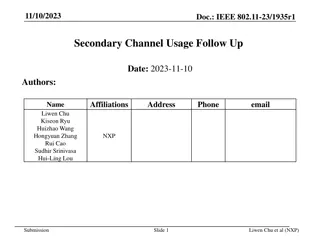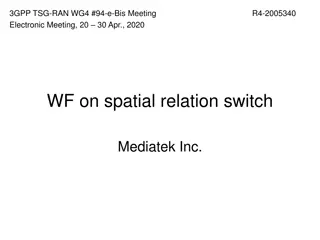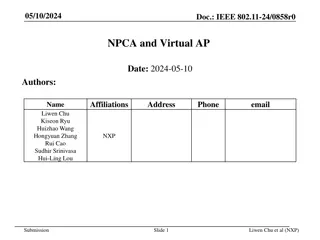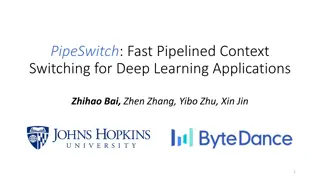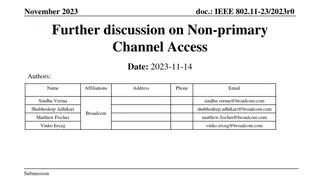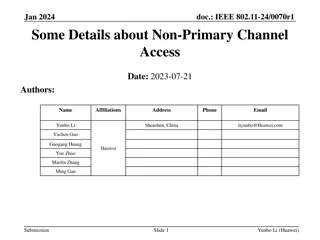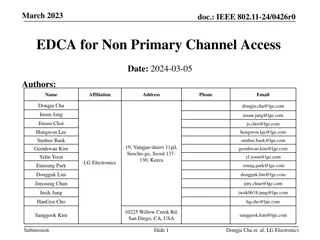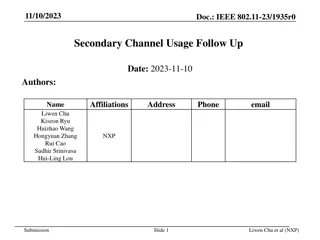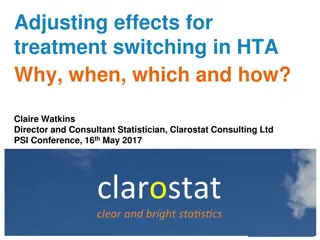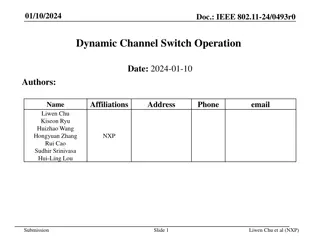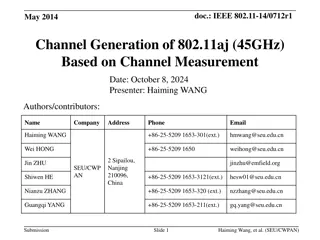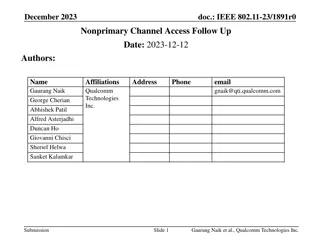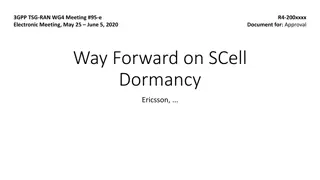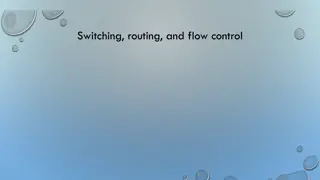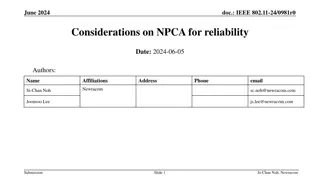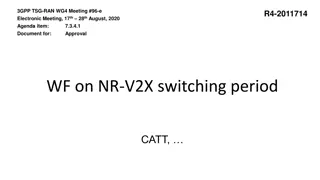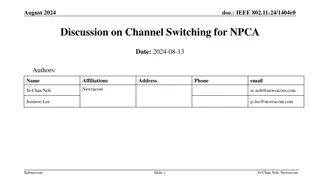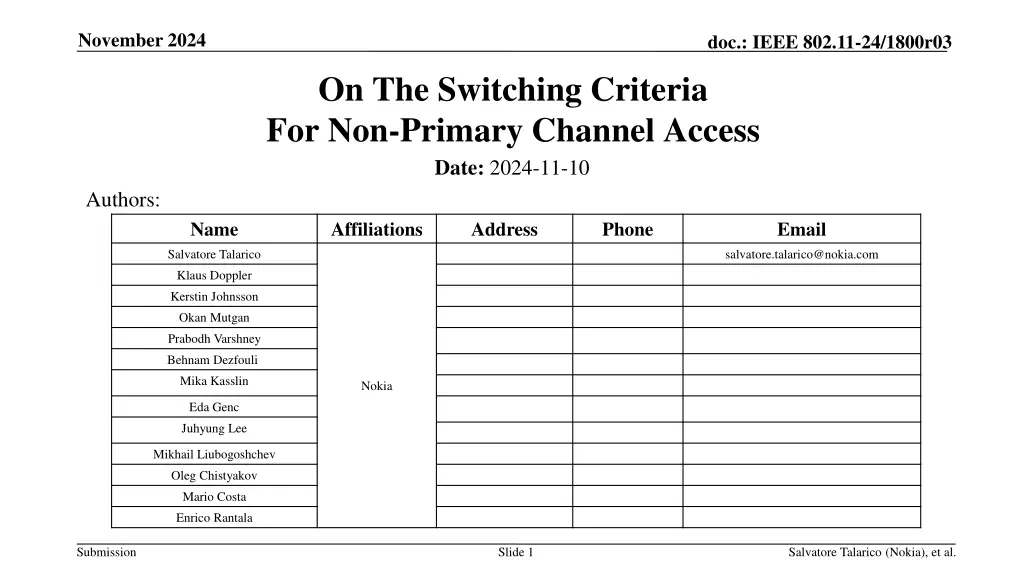
IEEE 802.11-24: Criteria for Non-Primary Channel Access
Explore the key aspects of IEEE 802.11-24/1800r03 report focusing on the switching criteria for non-primary channel access in wireless communication networks. Addressing issues related to NPAC and proposing solutions to optimize channel usage efficiency.
Download Presentation

Please find below an Image/Link to download the presentation.
The content on the website is provided AS IS for your information and personal use only. It may not be sold, licensed, or shared on other websites without obtaining consent from the author. If you encounter any issues during the download, it is possible that the publisher has removed the file from their server.
You are allowed to download the files provided on this website for personal or commercial use, subject to the condition that they are used lawfully. All files are the property of their respective owners.
The content on the website is provided AS IS for your information and personal use only. It may not be sold, licensed, or shared on other websites without obtaining consent from the author.
E N D
Presentation Transcript
November 2024 doc.: IEEE 802.11-24/1800r03 On The Switching Criteria For Non-Primary Channel Access Date: 2024-11-10 Authors: Name Affiliations Address Phone Email Salvatore Talarico salvatore.talarico@nokia.com Klaus Doppler Kerstin Johnsson Okan Mutgan Prabodh Varshney Behnam Dezfouli Mika Kasslin Nokia Eda Genc Juhyung Lee Mikhail Liubogoshchev Oleg Chistyakov Mario Costa Enrico Rantala Submission Slide 1 Salvatore Talarico (Nokia), et al.
November 2024 doc.: IEEE 802.11-24/1800r03 Introduction During the IEEE 802.11 Interim Meetings, the following motions were passed: Submission Slide 2 Salvatore Talarico (Nokia), et al.
November 2024 doc.: IEEE 802.11-24/1800r03 Problem Statement #1 The basic concept of NPCA ([1-9]) is to temporarily utilize an idle alternative channel as a primary channel, called here NPCA primary channel, when the BSS s primary channel is occupied. An AP and its associated non-AP STA may be subject to different interference conditions, which may trigger different behavior and dissociated switching at the two devices to the NPCA primary channel An example: OBSS transmission from AP2 overlaps with primary channel of AP1 and STA1/STA2. However, this is hidden from STA2, which believes the primary channel is idle. In this case, AP1 and STA1 will switch to a NPCA primary, while STA2 will not. Submission Slide 3 Salvatore Talarico (Nokia), et al.
November 2024 doc.: IEEE 802.11-24/1800r03 Proposal #1 To address the issue highlighted in prior slide Optional capability could be supported so that a device is able to sense and decode packets concurrently in both primary and NPCA primary channel Note: that this is not prevented by Motion already agreed since sensing and decoding is not done for the purpose of retrieving NAV information from the OBSS, but simply to assess whether a packet is coming from the associated AP Note: it is important to note that in this case no separate RF chains are necessary, but two physical or logical (software implementation) filters would be required If packet from associated AP is detected in the NPCA primary channel, then a non-AP STA shall switch from primary channel to NPCA primary channel regardless on whether it may sense its primary channel to be idle Submission Slide 4 Salvatore Talarico (Nokia), et al.
November 2024 doc.: IEEE 802.11-24/1800r03 Problem Statement #2 To limit the impact of NPCA on legacy devices and devices which may go in power mode while switching to an NPCA primary channel may occur, switching back to the reference primary channel shall occur as soon as possible An AP and its associated non-AP STA may be subject to different interference conditions, and while both may experience an OBSS overlapping with the primary channel the source of the interference may be different and also the related NAV information may be different. An example: OBSS transmission from AP3 and AP2 both overlap with the primary channel of AP1 and STA1. However, the OBSS transmission length from AP2 may be shorter than the OBSS transmission length from AP3. Since AP3 is hidden from AP1 and AP2 is hidden from STA1, AP1 will return to primary channel before STA1, and while AP1 will expect transmission on primary channel STA1 will continue to communicate with AP1 using the NPCA primary channel. Submission Slide 5 Salvatore Talarico (Nokia), et al.
November 2024 doc.: IEEE 802.11-24/1800r03 Proposal #2 To address the issue highlighted in prior slide one of the following approach could be pursued: Approach 1: The AP and its associated non-AP STA exchange information about the BSSID and Basic NAV timer information from the OBSS transmissions detected on the primary channel. Thus, the AP and its associated non-AP STAs that move to the NPCA primary channel know when exactly the other device will switch back on the primary channel. o Approach 2: The AP and its associated non-AP STA that move to the NPCA primary channel assume that a return to their primary channel occurs once their data exchange is complete from both sides (i.e., after a block ACK is sent or received). o Approach 3: A return from the NPCA primary channel to the primary channel is triggered by the AP via a specific announcement frame. o While designing a suitable procedure to address Problem #2, it is important to notice that several cases should be taken into consideration which may require special considerations Case #1: the AP and its associated non-AP STA have switched due to an OBSS transmission Case #2: One between an AP and its associated non-AP STA or both have switched because of an incumbent technology No knowledge of the BSSID and NAV information are possible to be retrieved from an incumbent Case #3: non-AP STA may switch due to overlapping with in-device technology overlapping with the primary channel and find that also AP has switched to NPCA primary channel No knowledge of the BSSID from non-AP perspective while it may be aware of the duration of the overlapping Submission Slide 6 Salvatore Talarico (Nokia), et al.
November 2024 doc.: IEEE 802.11-24/1800r03 Summary In this contributions two fundamental problems related to switching to or from an NPCA primary channel have been highlighted An AP and its associated non-AP STA may be subject to different interference conditions, which may trigger different behavior and dissociated switching to the NPCA primary channel at the two devices An AP and its associated non-AP STA may be subject to different interference conditions, and while both may experience an OBSS overlapping with the primary channel the source of the interference may be different and also the related NAV information may be different. Optional capability could be supported so that a device is able to sense and decode packets concurrently in both primary and NPCA primary channel so that to eliminate any ambiguity between an AP and its associated non-AP STA on when to switch to an NPCA primary channel. In order to have a coherent return into the primary channel after switching to a NPCA primary channel three methods are listed. Submission Slide 7 Salvatore Talarico (Nokia), et al.
November 2024 doc.: IEEE 802.11-24/1800r03 References [1] IEEE 802.11-23/34, Non-primary channel utilization, Sindhu Verma [2] IEEE 802.11-23/631, Secondary channel usage and secondary 20MHz channel backoff, Liwen Chu [3] IEEE 802.11-23/797, Non-primary channel access, Yongho Seok [4] IEEE 802.11-23/961, UHR secondary channel access, Minyoung Park [5] IEEE 802.11-23/1112, Thoughts on secondary channel access, Insun Jang [6] IEEE 802.11-23/1365, Discussions on non-primary channel access, Sanghyun Kim [7] IEEE 802.11-23/1891, Nonprimary Channel Access Follow-Up , Gaurang Naik [8] IEEE 802.11-23/1892, Thoughts on Dynamic Subchannel Operation , Gaurang Naik [9] IEEE 802.11-23/1911, Secondary channel access and frame transmission, Dongju Cha [10] IEEE 802.11-23/1913, Secondary channel access operation, Dongju Cha [11] IEEE 802.11-23/1951, Concurrent CCA for non-primary channel access, Leonardo Lanante Submission Slide 8 Salvatore Talarico (Nokia), et al.
November 2024 doc.: IEEE 802.11-24/1800r03 Straw Poll #1 Do you agree that an optional capability to allow a device to detect and decode a frame from a BSS concurrently from both primary and NPCA primary channel is beneficial? Yes No Abstain Submission Slide 9 Salvatore Talarico (Nokia), et al.
November 2024 doc.: IEEE 802.11-24/1800r03 Straw Poll #2 Do you agree that a procedure/mechanism is needed to be define in 802.11bn to allow harmonized switching between both AP and associated non-AP STA from the NPCA primary channel back to the reference primary channel? Yes No Abstain Submission Slide 10 Salvatore Talarico (Nokia), et al.



